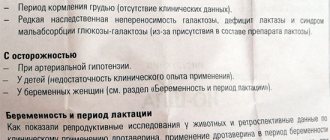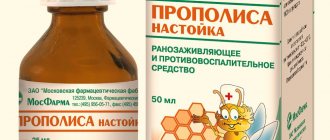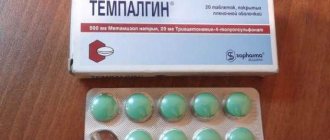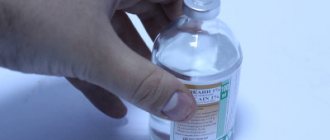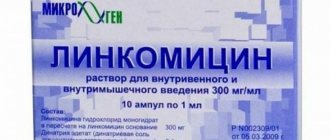Paracetamol for toothache
Every person experiences toothache in life.
It can be so strong that there are no thoughts left in your head except one: how to get rid of it. We open the home medicine cabinet and frantically begin to look for painkillers there. Analgin, Ketanov, Baralgin, Spasmalgon... They all have a number of contraindications (for example, pregnancy or breastfeeding), and are not always available. But paracetamol is probably present in first aid kits. Even if it is not available, this drug can easily be purchased at your local pharmacy.
Paracetamol
Of course, the drug does not have such a pronounced analgesic effect as the above drugs, but it can also help relieve pain and improve well-being.
Therefore, if toothache occurs, start treatment with paracetamol . It will be safer this way. The drug can not only relieve pain, but also relieve fever if it occurs, and reduce the inflammatory process. By acting on the center of thermoregulation and pain, paracetamol lowers the temperature as naturally as possible and is removed from the organs and tissues of the body. Does not affect water-electrolyte metabolism.
While providing an analgesic effect, paracetamol does not relieve the cause of the disease. To eliminate them, you need to urgently consult a dentist.
Indications and contraindications for use, release forms
Paracetamol is indicated for:
- Moderate to mild pain syndrome.
- Infectious and inflammatory processes in the oral cavity.
- Increased body temperature.
However, for some diseases this drug must be approached very carefully.
Acute toothache
Paracetamol is not indicated:
- With severe renal and liver failure.
- In case of intolerance to the main component of the drug.
- For chronic alcoholism and alcoholic liver damage.
- For acute inflammatory diseases of the stomach and intestines, erosions and ulcers.
Paracetamol is available in tablets, which can be white or white with a creamy tint. It can also be in the form of capsules, suspensions, syrups and suppositories, which contain paracetamol as the main active ingredient and auxiliary additives, depending on the form produced.
For toothache, the use of the drug in the form of syrup and suspension is not recommended.
Causes of tooth pain
Pain in the teeth occurs for various reasons. Generally speaking, irritation of receptors in the area of the dental pulp occurs. Sometimes it appears after exposure to cold or heat, sometimes when touched, another type of pain is pulsating in nature and begins suddenly.
Everything is very individual. Diseases that are accompanied by toothache - caries, pulpitis, increased sensitivity of the gums. And these are just the most popular of all ailments.
The most common cause of tooth pain is the formation of a carious cavity. In patients with this disease, pain does not appear immediately. The initial stage does not have any symptoms other than darkening of the tooth enamel.
We suggest you familiarize yourself with: Nimesil for toothache, gumboil, and tooth extraction. How to take nimesil for toothache
However, if you do not start timely treatment, the tooth begins to hurt very much even when you lightly touch it with the tip of your tongue. Pulpitis is characterized by severe and throbbing pain, which intensifies at night.
Periodontitis is accompanied by virtually constant pain with sharp attacks. If you press on a tooth, the pain intensifies to such an extent that subsequently it can no longer be touched.
Sometimes the pain appears in the middle of the working day, when there is no way to put everything aside and go to the dentist’s office. Then people begin to look for medications to ease the pain a little.
How to take the drug
Like all medications, paracetamol is used strictly in accordance with the instructions. For adults, no more than 1 g of the drug is recommended at a time. Daily dose 4 g.
If an excess amount of medication enters the bloodstream, acute intoxication and liver damage are possible. A fatal outcome cannot be ruled out . Negative consequences may occur after using ten times the recommended dose of the drug. For those suffering from alcoholism, a dose of 3-4 g of the active substance may be critical.
Incompatibility with some drugs is detailed in the instructions for use of paracetamol.
Of course, during a toothache it is difficult to read the small text of the instructions, but still, in order not to harm your health, you must read it carefully. When taking sedatives that have a pronounced hypnotic effect, it is better to avoid taking paracetamol. It should not be used with other medications that also contain paracetamol to avoid overdose.
Taking paracetamol during pregnancy
Particular care should be taken when taking medications during pregnancy. What to do if the expectant mother has a toothache? We can say for sure that paracetamol can be used by pregnant women.
Pregnant woman.
In the first trimester of pregnancy
In the first trimester of pregnancy, the fetus is just beginning to develop. The baby is not yet protected by the placenta. And any drug will have an effect on him, just like on the expectant mother.
Therefore, paracetamol can be used during the first trimester of pregnancy when the benefit from it is greater than the threat to the fetus.
When toothache becomes unbearable, which causes stress in the mother, and the temperature also rises, threatening the death of the fetus, it is necessary to take urgent measures. Paracetamol comes to the rescue. The best form of application would be rectal suppositories , as they do not irritate the stomach and are well absorbed into the blood. They are not able to cause the already present nausea in the early stages of a woman’s interesting situation.
Rectal suppositories
In the second and third trimesters
If toothache occurs, the drug can also be used. But here, too, special caution must be exercised. As the fetus grows, the expectant woman in labor increases the load on her organs. As a result, a number of symptoms may occur that will be a contraindication for the use of paracetamol. These include renal and hepatic colic, problems with veins and blood vessels. The drug can thicken the blood, thereby exacerbating the disease.
The dosage of the drug during pregnancy should be minimal, and the number of days of taking it should also not be delayed. Usually, for toothache, pregnant women are recommended to take the medicine twice a day; the treatment time should not exceed 4-5 days.
Paracetamol is considered one of the least safe antipyretic, analgesic and anti-inflammatory non-steroidal drugs.
Will paracetamol help?
Paracetamol cannot be classified as an innovative medicine. It was discovered 120 years ago and since then has been consistently used as an antipyretic and analgesic. It also has an anti-inflammatory effect, but it is very insignificant. Unlike most non-steroidal anti-inflammatory drugs, paracetamol does not irritate the gastric mucosa and does not disrupt water-mineral metabolism. That is why it is considered a much safer drug than, for example, aspirin.
Paracetamol is available without a prescription and is present in almost every home medicine cabinet, if not in pure form, then as part of other medications. Efferalgan, Flutabs, Panadol, Tynelol - this is not a complete list of drugs that include paracetamol as the main active ingredient. Therefore, they can also be taken to at least temporarily get rid of acute or aching toothache.
How does paracetamol work for toothache? Special active physiological substances – prostaglandins – are responsible for the sensation of pain in the body. They are the ones who send an SOS signal to the brain when something goes wrong. Paracetamol has the ability to successfully fight these substances, significantly inhibiting their formation. It turns out that the problem essentially does not go away - the inflammation in the tooth continues to progress, but the brain does not know about it, which means the process is painless.
Paracetamol does not cure a tooth, but only temporarily relieves pain. This is why it is so important not to overuse bitter painkillers, but to sit in the dental chair at the first opportunity! By postponing treatment, it is easy to start caries and allow the occurrence of pulpitis or an even more severe form of inflammation - periodontitis.
While breastfeeding
The use of this drug is permitted. A very small amount of paracetamol (no more than 0.23%) passes through mother's milk to the baby.
It is better for a nursing mother to take the medicine after feeding. Since its effect begins within 20-30 minutes, and it is eliminated from the body within 4 hours.
Breast-feeding
In this case, by the beginning of the next feeding, harmful substances will not reach the baby. If there is a need to feed the child earlier, then you should remember that the peak concentration of the active substance in the body occurs an hour after taking it. Based on this, you should calculate the baby's feeding schedule.
Is it possible for pregnant and lactating women
Taking any medications while pregnant is not advisable. This is especially true during the first trimester of pregnancy, when the rudiments of the organs and systems of the fetus are formed. But the fact is that it is precisely this interesting position that often becomes the cause of dental problems. Hormonal changes, toxicosis and an ever-growing baby, which takes away the lion's share of beneficial vitamins and microelements from the mother's body, can trigger the development of caries.
Of course, you can relieve pain symptoms with folk remedies - herbs, rinses, but often their effectiveness is negligible. In this case, gynecologists prescribe paracetamol to their pregnant patients as a pain reliever. Its advantage is that it works purposefully - directly at the epicenter of pain and at the same time practically does not affect other organs. Can the active substance cross the placenta? Yes, but with minimal dosages and short-term use it does not harm the child.
For those who have successfully completed this stage and are now enjoying breastfeeding, paracetamol is also allowed. Only 0.23% of the tablet will pass into milk. This is a small dose and, when taken once, is absolutely harmless to the baby.
To further protect your baby from possible side effects, it is better to take pain medication immediately after feeding. By the time the next feeding comes, namely after 3-4 hours, the drug will be completely eliminated from the mother’s body, so that her child will not feel the effect of the medication. For those who do not adhere to schedules and practice feeding on demand, there is another rule: do not put the baby to the breast half an hour after taking the pill - this is the time when the concentration of active substances in the body peaks.
In any case, it is necessary to take a responsible attitude towards the signals that the body sends. Instead of trying to suppress them and eliminate the symptoms, it is better to take appropriate measures without delay and eliminate the cause. The maximum period for which you can postpone a visit to the dentist is 3 days. This is how much paracetamol can be taken without harm to organs and systems. Despite the good compatibility of the drug with other medications, at this time it is better to stop taking sedatives (so-called barbiturates), which have a pronounced sedative and hypnotic effect.
Sources used:
- Teeth are forever healthy and beautiful / Maren von Pluta. - M.: Sigma-press, 1997.
- Medicines in dentistry / I.K. Lutskaya. - Moscow
- Meremikwu M, Oyo-Ita A.
Paracetamol for treating fever in children // Cochrane Database Syst Rev. — 2002. - National Library of Medicine (USA)
The use of paracetamol for the treatment of children
When teething, children in the first years of life may experience fever and pain. For such symptoms, the pediatrician prescribes paracetamol. Its single dose should not exceed 10 mg/kg of the child’s weight. The medicine can be given to the baby to drink in the form of a solution, or used in the form of suppositories.
Suppositories are absorbed into the blood more slowly, but their effect on the child’s body is longer. When using paracetamol in children, you must also read the instructions for use of the drug in order to correctly calculate the required amount.
Tsifecon D - paracetamol suppositories for children
For children over three years of age, the maximum dose of the active substance should not exceed 60 mg/kg body weight. The average dose of medication for children 3-6 years old is no more than 100 - 200 mg per dose. For children 6-12 years old – 200-400 mg. Children can take it every 4 hours.
